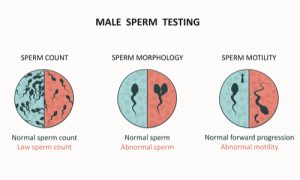Apart from problems that prevent sperm production in the first place, you may not realize what factors affect male fertility.
Factors such as motility, count and volume dictate semen integrity. They play an essential role in a man’s reproductive potential. Ultimately, they determine the odds of initiating a successful pregnancy.
Taking an active role in understanding sperm health is a good first step to starting a family. If you are curious about your reproductive health and how to improve it, you might consider a semen analysis.
What is a Semen Analysis?
A semen analysis—sometimes called a “sperm count” test—is also more technically known as a seminogram. It is a diagnostic test that considers three main elements of sperm cells:
- the number of cells,
- the shape of cells, and
- the movement of cells (motility).
The fertility journey includes several tests to identify the cause of fertility issues. With more information, doctors usually have an idea of how to increase the odds of conceiving. A seminogram helps them develop a plan—from lifestyle changes to fertility treatments—for the patient.
A semen analysis is a noninvasive test that men can do at home or in a controlled environment. In-home tests only track count data, which does not necessarily confirm fertility. At-home screenings are a good start, but they cannot replace andrology lab evaluations.
Professional lab tests analyze all three characteristics noted above—sperm count, shape and motility. The results can expose a variety of problems based on semen integrity.
What Can a Semen Analysis Find?

- the absence of sperm, denoting infertility;
- low pH levels, indicating blockage;
- poor movement, preventing pregnancy;
- fluid issues, which weaken fertility; and
- colored semen, representing infection.
A semen analysis can uncover other problems, as well. Gene defects, hormone imbalances, sexually-transmitted infections and overexposure to chemicals are some examples. Even if male fertility is not a concern, a seminogram can still benefit couples.
How Often Should Men Test Their Sperm?
Doctors usually conduct two or three separate analyses to form an understanding of sperm health. The American Association of Clinical Chemistry (AACC) recommends testing at least seven days apart, over the course of two or three months.
Fertility experts suggest monthly tests, outside of the six-day interval when pregnancy can occur. Men should abstain from ejaculation the same amount of time (2–7 days) before each test. This ensures the most accurate results.
Who Is a Good Candidate for a Sperm Analysis?
After six months of unsuccessful pregnancy attempts, couples may benefit from a semen analysis. Since men and women share a mutual responsibility for conception, it is good to take initiative on both fronts.
In addition to the above time references, men who plan to take a semen test should talk to their doctors about factors that could affect their fertility. They should discuss obesity, drug or alcohol abuse, tobacco use, cancer, hormones, medications and more.
Conclusion
Being proactive about sperm health can help men achieve better personal health. For couples who want to start a family, it can help them find the right solutions to their fertility problems. If you are on a fertility journey, it can lead you and your partner to the family of your dreams.




